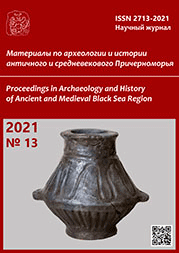Налобные и нащечные пластины конского убора IV — начала II вв. до н.э. из памятников Ставропольской возвышенности
Horse frontlets and cheek-guards of the 4th — early 2nd centuries BCE from monuments of Stavropol Upland
Author(s): Yuriy A. ProkopenkoSubject(s): History, Archaeology, Cultural history, Ancient World
Published by: Нижневартовский государственный университет
Keywords: Central Ciscaucasia; Stavropol Upland; horse decoration; lamellar armbits; horse patches; the art of Koban culture; Scythian animal style; metal working;
Summary/Abstract: The article discusses eleven horse prometopidia (frontlets and chanfrons) and four cheek-guards found on the territory of Stavropol Upland. The artifacts in question were revealed while exploring archaeological sites and findspots near Stavropol; these are: the burial ground No. 2 of Tatarskoe Hillfort (crypt No. 1), the burial ground No.4 in selfsame area, the hoard of horse body armor and ornaments found northwest of Stavropol and dated back from the 4th to the 2nd century BCE, and, finally, some artifacts found near Aleksandrovsk. In the 4th century BCE, in addition to battle protective equipment per se, some casted frontlets and chanfrons were used exclusively for ornamental purposes. As a rule, some of these are small in size, to only cover a part of a horse’s head, and some are openwork. In total, three bronze frontlets and two chanfrons are dated back to the 4th century BCE. These include: (a) two elongated trapezoids found near Aleksandrovsk, (b) an openwork rectangle-shaped frontlet of the Stavropol hoard, punctured with rows of triangles, with rectangular projections along the end margins, and (c) zoomorphically shaped plate-like chanfrons and cheek-guards of the same hoard. In the vicinity of Stavropol, a total of five prometopidia and two cheek-guards are reported to be found, which are similar to those discovered in Kuban Region. These finds are dated back to the late 3rd and the early 2nd century BCE. Judging by decorative features of the barding equipment occurred from Stavropol Upland, local craftsmen of the 4th and the 3rd century BCE were influenced from two sources. Specifically, some distinctive elements of the traditional art of the Koban cultural and historical community and the Kuban version of the Scythian animal style are observed. A pair of S-shaped ornamental cheek-guards representing images of a cockerel or a hippocampus is of Middle Dnieper origin.
Journal: Материалы по археологии и истории античного и средневекового Причерноморья
- Issue Year: 2021
- Issue No: 13
- Page Range: 467-482
- Page Count: 16
- Language: Russian

